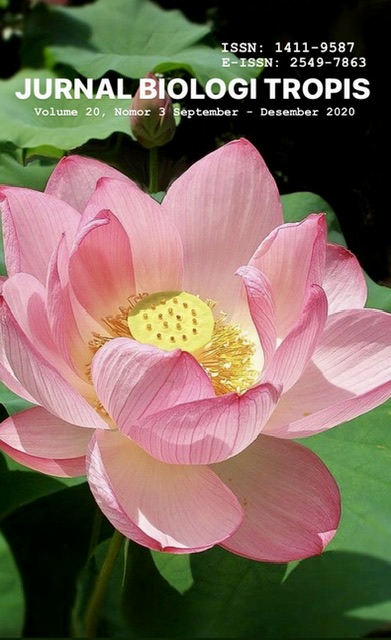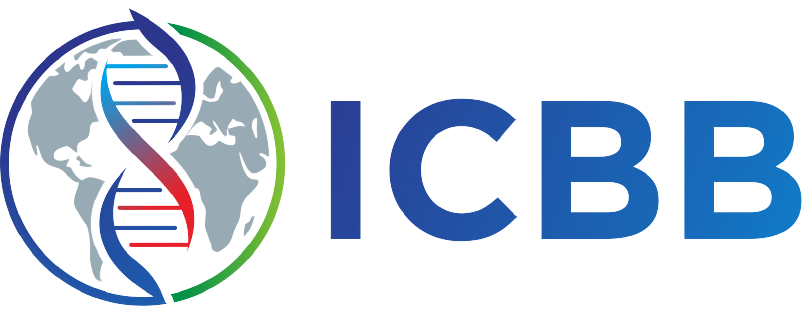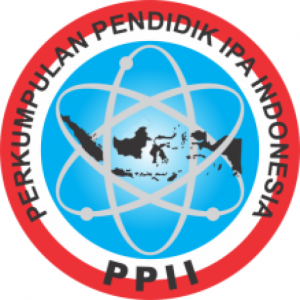The Composition, Abundance, and Biodiversity of the Insect Family of the Hymenoptera Order on Swampy Wetlands (SW) and Land Conversion (LC) in Palembang City
Authors
Riyanto RiyantoDOI:
10.29303/jbt.v20i3.2068Published:
2020-11-06Issue:
Vol. 20 No. 3 (2020): September - DesemberKeywords:
Composition, abundance, biodiversity, Hymenoptera, and PalembangArticles
Downloads
How to Cite
Downloads
Metrics
Abstract
Urban development and population growth in the Palembang city, lowland swamps have been converted into swamps (SW) and land conversion (LC). Changes in habitat certainly have an impact on the composition, abundance, and diversity of the insect family of the Hymenoptera order. The purpose of writing this article is to inform the composition, abundance, and diversity of insect families of the Hymenoptera order in the SW and LC lands of Palembang city. This study used a survey method by exploring each research location four times. Determination of the research location using purposive sampling method with the reason to get different habitat conditions. The collection of insects is carried out in two ways, namely trapping and hands collecting. The results showed that 18 families of the Hymenoptera order, namely 4 to 7 families were found in SW land and 8 families were found in LC land. The number of individuals on SW land was 6,351 and on LC land was 2,297. The Apidae, Formicidae, Ichneumonidae, Platygastridae, Sphecidae, and Vespidae families are found in almost all fields. The total abundance index of the Hymenoptera order family in SW land (73.438%) was higher than the index of the total abundance of the Hymenoptera order family in the LC land (26.561%). The highest family abundance index was Formicidae, namely 65.101%, followed by the Vespidae family (26.237%) and the Apidae family (5.087%). The diversity index of the Hymenoptera order in the LC land had a higher value (2.741) than the diversity index in the SW field (2.165). The conclusion is that the composition of the insect family of the Hymenoptera order in LC land was higher than in SW land, but the number of individual insects in SW land was higher than in LC land. The abundance index of the Hymenoptera order in SW land was higher than that in LC land. The insect diversity index of the Hymenoptera order in LC land was higher than in SW land. It is recommended to research the role of various insect species from the Hymenoptera order in the SW land and LC land of theÃÂ Palembang city.References
Asyari (2006). Peran Serangga Air Bagi Ikan Air Tawar. BAWA. 1 (2): 12-19.
Borror, D, J., Triplehorn, C.A., & Johnson, N.F. (2005). Study of Insects. 7 the Edition. Thomson Brooks/Cole. Australia, Canada, Singapura, Spain, United Kingdom, United States.
Diniz, S., 1, Prado, P., & Lewinsohn, T. M. (2010). Species Richness in Natural and Disturbed Habitats: Asteraceae and Flower-Head Insects (Tephritidae: Diptera). Neotropical Entomology, 39(2):163-171.
Dobermann, D, Swift, J.A. & Field, L.M. (2017). Opportunities and hurdles of edible insects for food and feed. Nutrition Bulletin. (42): 293ââ¬â308.
Froidevaux, J. S. P., Louboutin, B. & Jones, G. (2017). Does organic farming enhance biodiversity in Mediterranean vineyards? A case study with bats and arachnids. Agriculture, Ecosystems, and Environment 249: 112ââ¬â122. http://dx.doi.org/10.1016/j.agee.2017.08.012.
Getanjaly, Rai, V. L., Sharma, P. & Kushwaha, R. (2015). Beneficial Insects and their Value to Agriculture. Res. J. Agriculture and Forestry Sci. 3 (5): 25-30.
Girsang, P. (2018). Serangga, Solusi Pangan Masa Depan. Jurnal Pembangunan Perkotaan. 6 (2): 69-76.
Goulet, H. & Huber, J.T. (1993). Hymenoptera of the world: An identification guide to families. Research Branch Agriculture Canada Publication l894/E. Ontario.
Herlinda, S., Waluyo, Estuningsih, S.P., & Irsan, C., (2008). Perbandingan Keanekaragaman Spesies dan Kelimpahan Arthropoda Predator Penghuni Tanah di Sawah Lebak yang Diaplikasi dan Tanpa Aplikasi Insektisida. J. Entomol. Indon. 5 (2): 96-107.
Hidayat, P. (2015). Serangga dalam Kehidupan Manusia: Teman Sekaligus Lawan. Prosiding Seminar Nasional Perhimpunan Entomologi Malang, 1-2 Oktober 2015.
Hoermann1, C.V., Weithmann, S., Deibler, M., Manfred Ayasse, M. & Steiger, S. (2020). Forest habitat parameters influence abundance and diversity of cadaver-visiting dung beetles in Central Europe. R. Soc. open sci. (7) : 1-15. http://dx.doi.org/10.1098/rsos.191722.
Imathiu, S. (2019). Benefits and food safety concerns associated with consumption of edible insects. NFS Journal. 18: 1ââ¬â11.
Jansson, A & Berggreen, A. (2015). Insects as Food ââ¬â Something for the Future? A report from Future Agriculture. Uppsala, Swedish University of Agricultural Sciences (SLU).
Lapolla, J. S., Cheng, C. & Fisher, B.L. (2010). Taxonomic revision of the ant (Hymenoptera: Formicidae) genus Paraparatrechina in the Afrotropical and Malagasy Regions. Zootaxa, 2387: 1ââ¬â27.
Ludwig, J.A. & J.F. Reynold (1988). Statistical Ecology: a Primer on Methods and Computing. John Wiley & Sons.New York.
Latumahina, F.S., Musyafa, Sumardi & Putra , N. S., (2014). Kelimpahan dan Keragaman Semut dalam Hutan Lindung Sirimau Ambon. Biospecies. 7 (2): .53-58.
Keroumi, A.E., Naamani, K., Soummane, H. & Dahbi, A. (2012). Seasonal dynamics of ant community structure in the Moroccan Argan Forest. Journal of Insect Science, 12 (94) : 1-19. Available online: http://www.insectscience.org/12.94
Malgorzata, B., Johan, A., Johannes, B., Ulf, B.,Tuija, H-R., & Frank, J., (2016). Effects of management intensity, function, and vegetation on the biodiversity in urban ponds. Urban Forestry & Urban Greening (20): 103ââ¬â112. http://dx.doi.org/10.1016/j.ufug.2016.08.012.
Meilin, A. & Nasamsir (2016). Serangga dan Peranannya dalam Bidang Pertanian Dan Kehidupan. Jurnal Media Pertanian. 1 (1): 18 ââ¬â 28.
Morandin, L.A., Long, R. F & Kremen, C. (2016). Pest Control and Pollination Cost-Benefit Analisis of Hedgerow Restoration in a Simplified Agricultural Landscape. Journal of Economic Entomology, 109(3): 1020ââ¬â1027. https://doi: 10.1093/jee/tow086.
Odum, E.P. (1998). Dasar-dasar Ekologi. Alih Bahasa : Samingan, T dan B. Srigandono. Edisi Ketiga Universitas Gadjah Mada Press, Yogyakarta
Payne, C.L.R. & Itterbeeck, J.V. (2017). Ecosystem Services from Edible Insects in Agricultural Systems: A Review. Insects. 8 (24): 1-20. https://doi:10.3390/insects8010024. www.mdpi.com/journal/insects.
Peck, S.L., B. McQuaid & C.L. Campbell (1998). Using Ant Species (Hymenoptera: Formicidae) as biological indicator of agroecosystem condition. Community and Ecosystem Ecology. Environmental Entomology. 27: 1102-1110.
Pranadji, Tri & Saptana (2005). Pengelolaan Serangga dan Pertanian Organik Berkelanjutan di Pedesaan: Menuju Revolusi Pertanian Gelombang Ketiga di Abad 21. Forum Penelitian Agro Ekonomi. 23 (1) : 38 ââ¬â 47.
Putra, I. M , Hadi , M & Rahadian, R. (2017). Struktur Komunitas Semut (Hymenoptera: Formicidae) di Lahan Pertanian Organik dan Anorganik Desa Batur, Kecamatan Getasan, Kabupaten Semarang. Bioma. 19 (1):. 170-176.
Retallack, M. (2011). Vineyard Biodiversity and Insect Interactions - Establishing and Monitoring Insectariums. GWRDC Regional ââ¬â SA Central, Adelaide Hills, Currency Creek, Kangaroo Island, Langhorne Creek, McLaren Vale, and Southern Fleurieu Wine Regions.
Romoser & Stoffolano (1998). The Science of Entomology. Fourth Edition. A Division of The McGraw-Hill Companies. Boston, Massachusetts Burr Ridge, Illinois Dubuque, Iowa Madison, Wisconsin New York, New York, San Francisco, California, St. Louis, Missouri.
Ross, N. & Huis, A. V. (2017). Consuming insects: are there health benefits? Journal of Insects as Food and Feed. 3(4): 225-229.
Semiun, C.G & Stanis, S. (2016). Kelimpahan dan Keanekaragaman Arthropoda Tanah pada Lahan Pertanian Monokultur dan Polikultur di Desa Labat Kupang. BioWallacea, 2 (2):154-1 61.
Setiani, E.G., Rizali, A., Moerfiah, Sahari, B & Buchori, D. (2010). Keanekaragaman Semut pada Persawahan di Daerah Urban: Investigasi Pengaruh Habitat Sekitar dan Perbedaan Umur Tanaman Padi. J. Entomol. Indon., 7 (2): 88-99.
Soesanthy, F. & Trisawa, I. M. (2011). Pengelolaan Serangga-Serangga yang Berasosiasi dengan Tanaman Jambu Mete. Buletin RISTRI . 2 (2): 221-230.
Tang, C.,Yang, D., Liao, H., Sun, H., Liu, C., Wei, L., & Li, F. (2019). Edible insects as a food source: a review. Food Production, Processing, and Nutrition, 1 (8):1-13. https://doi.org/10.1186/s43014-019-0008-1.
Tawakkal, M.I., Rizali, A., Larasati, A., Sari, A., Hidayat, P., & Buchori, D. (2019). Tipe Penggunaan Lahan memengaruhi Keanekaragaman dan Komposisi Hymenopteran Parasitoid di Jambi. J. Entomol. Indon., 16 (3): 151ââ¬â162.
Triyogo, A. Budiadi, Widyastuti, S.M., Subrata, S.A. & Budi, S.S. (2020). The abundance of ants (Hymenoptera: Formicidae) and the functional groups in two different habitats. Biodiversitas 21 (5): 2079-2087,
Wanjui, J., (2013). Biodiversity Conservation Needs and Method to Conserve the Biological Diversity. J. Biodivers Endanger Species 2013, 1:3 https:// doi: 10.4172/2332-2543.1000113.
Yulminartiab, Syamsudin, T.S.S., Salmah, S. & Amrizal Saidi, A. (2015). Perubahan Jumlah Spesies dan Jumlah Individu serta Laju Pergantian Spesies Semut (Hymenoptera: Formicidae) pada Lahan Gambut Alami Yang Dibuka. Prosiding Seminar Nasional Biodiversitas dan Ekologi Tropika Indonesia 2015 BIOETI 3 Padang tanggal 9 september 2015.
Author Biography
Riyanto Riyanto, Sriwijaya University
License

Jurnal Biologi Tropis is licensed under a Creative Commons Attribution 4.0 International License.
The copyright of the received article shall be assigned to the author as the owner of the paper. The intended copyright includes the right to publish the article in various forms (including reprints). The journal maintains the publishing rights to the published articles.
Authors are permitted to disseminate published articles by sharing the link/DOI of the article at the journal. Authors are allowed to use their articles for any legal purposes deemed necessary without written permission from the journal with an acknowledgment of initial publication to this journal.


























